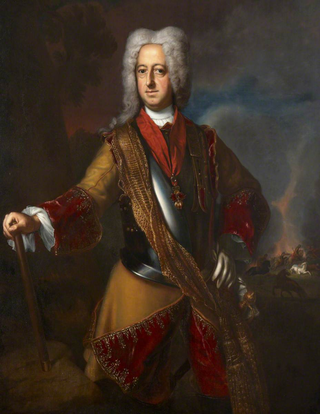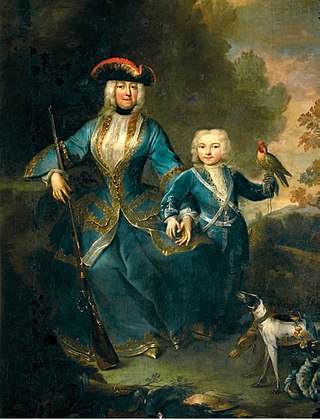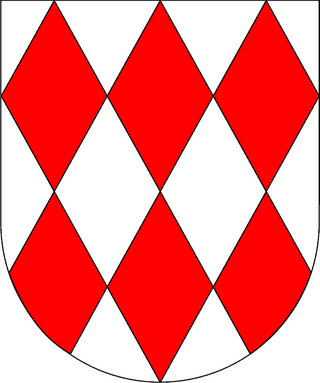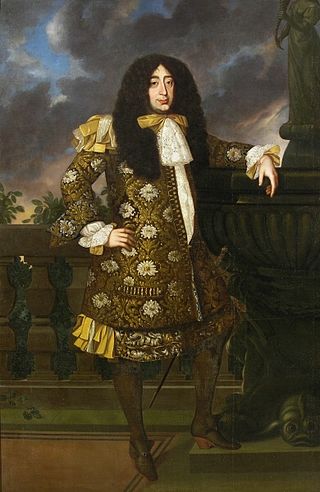Sources
- Genealogie Online
- ADB
- BLKÖ
- Heinrich Franz von Mansfeld in Austria-Forum (in German) (at AEIOU)
- Säbi
Heinrich Franz von Mansfeld, Prince of Fondi (Bornstedt, November 21, 1640, Vienna, June 18, 1715) was an Austrian diplomat, Field marshal and President of the Hofkriegsrat.
Heinrich Franz came from the powerful House of Mansfeld, and was the second son of Count Bruno von Mansfeld (1576-1644) and his second wife, Baroness Maria Magdalena von Törring (1616-1668). Imperial Field marshal Count Philipp von Mansfeld was his uncle.
He entered the Habsburg service at a young age. After a short military service, he was almost always in court or on diplomatic service. From 1680 to 1682 he was Envoy to the French court and from 1683 to 1690 to the Spanish court. Despite his very limited military experience, he was continuously promoted to higher military ranks and even became a Field marshal in 1689.
From 1684 to 1701 he was Obersthofmarschall at the Imperial court in Vienna and in 1701 he was appointed President of the Hofkriegsrat (Court War Council). In this position he repeatedly clashed with Prince Eugene of Savoy. In 1703 Mansfeld, who was unpopular with most Army generals, was relieved of this post and replaced by Eugene of Savoy. Until his death he remained as Chief Chamberlain at the Viennese court.
In 1690, he accompanied Princess Maria Anna of Pfalz-Neuburg as bride of King Charles II of Spain to her wedding in Valladolid. For this, the Spanish King awarded him the Neapolitan principality of Fondi, the title of Spanish Grandee and the Spanish Order of the Golden Fleece. The dignity of Imperial Prince granted to him, was confirmed in 1696 and 1709 and made public by Emperor Joseph I in 1711.
From 1697, he had Johann Lukas von Hildebrandt build a pleasure palace with a garden, which still unfinished, the Schwarzenberg family acquired after his death. This palace, now known as the Schwarzenberg Palace, became an important Viennese architectural monument.
In 1679, he married Countess Marie Louise of Aspremont-Lynden, widow of Charles IV, Duke of Lorraine. They had 2 daughters:

Maximilian II, also known as Max Emanuel or Maximilian Emanuel, was a Wittelsbach ruler of Bavaria and a Prince-elector of the Holy Roman Empire. He was also the last governor of the Spanish Netherlands and Duke of Luxembourg. An able soldier, his ambition led to conflicts that limited his ultimate dynastic achievements.

The Belvedere is a historic building complex in Vienna, Austria, consisting of two Baroque palaces, the Orangery, and the Palace Stables. The buildings are set in a Baroque park landscape in the third district of the city, on the south-eastern edge of its centre. It houses the Belvedere museum. The grounds are set on a gentle gradient and include decorative tiered fountains and cascades, Baroque sculptures, and majestic wrought iron gates. The Baroque palace complex was built as a summer residence for Prince Eugene of Savoy.

Anton Florian was the Prince of Liechtenstein between 1718 and 1721.

Count Ernst Rüdiger von Starhemberg was military governor of Vienna from 1680, the city's defender during the Battle of Vienna in 1683, Imperial general during the Great Turkish War, and President of the Hofkriegsrat. By birth he was member of the House of Starhemberg.

Palais Schwarzenberg is a Baroque palace in front of Schwarzenbergplatz, Landstraße, the 3rd district of Vienna, Austria. It is owned by the princely Schwarzenberg family.

The Hofkriegsrat established in 1556 was the central military administrative authority of the Habsburg monarchy until 1848 and the predecessor of the Austro-Hungarian Ministry of War. The agency was directly subordinated to the Habsburg emperors with its seat in Vienna.

Johann Ernst of Nassau-Weilburg was an Imperial Generalfeldmarschall, from 1675 to 1688 Count and from 1688 until his death Prince (Fürst) of Nassau-Weiburg.

Eleonore von Schwarzenberg was a member of the Princely House of Lobkowicz by birth, and a Princess of Schwarzenberg by marriage.

The House of Mansfeld was a princely German house, which took its name from the town of Mansfeld in the present-day state of Saxony-Anhalt. Mansfelds were archbishops, generals, supporters as well as opponents of Martin Luther, and Habsburg administrators.

Eugen Alexander Franz, 1st Prince of Thurn and Taxis, full German name: Eugen Alexander Franz Fürst von Thurn und Taxis was the first Prince of Thurn and Taxis, Postmaster General of the Kaiserliche Reichspost, and Head of the House of Thurn and Taxis from 13 September 1676 until his death.

Marie Louise, Countess of Aspremont-Lynden, was a Duchess consort of Lorraine.

Theodor Heinrich von Strattmann was an Austrian statesman. He came from a distinguished historical family.

Ferdinand Joseph, Prince of Dietrichstein, was a German prince member of the House of Dietrichstein, 3rd Prince (Fürst) of Dietrichstein zu Nikolsburg, Princely Count of Tarasp, Baron (Freiherr) of Hollenburg, Finkenstein and Thalberg; in addition, he served as Lord Chamberlain (Obersthofmeister), Conference Minister (Konferenzminister) and Privy Councillor (Geheimrat) of Emperor Leopold I, and Knight of the Order of the Golden Fleece since 1668.

Maximilian, Prince of Dietrichstein, was a German prince member of the House of Dietrichstein, Imperial Count (Reichsgraf) of Dietrichstein and owner of the Lordship of Nikolsburg in Moravia; since 1629 2nd Prince (Fürst) of Dietrichstein zu Nikolsburg, Baron (Freiherr) of Hollenburg, Finkenstein and Thalberg, was a diplomat and minister in the service of the House of Habsburg. He was a Kämmerer, Lord Chamberlain (Obersthofmeister), Conference Minister (Konferenzminister) and Privy Councillor of Emperors Ferdinand II and Ferdinand III, Knight of the Order of the Golden Fleece since and ruler over Nikolsburg, Polná, Kanitz, Leipnik, Weisskirch and Saar.

Ferdinand Wilhelm Eusebius Prince of Schwarzenberg was a German-Bohemian nobleman from the Schwarzenberg family.

Adam Franz Prince of Schwarzenberg, 3rd Prince of Schwarzenberg, was a Bohemian nobleman from the Schwarzenberg family and Austrian Obersthofmarschall.

Countess Eleonore Batthyány-Strattmann was a Viennese court lady. The daughter of Imperial Court Chancellor Count Theodor Heinrich von Strattmann und Peuerbach, she was married to Hungarian nobleman and Ban of Croatia Ádám II Batthyány until his early death in 1703. For more than twenty years after becoming a widow she was Prince Eugene of Savoy confidante, companion and some have suggested Éminence grise. One of the most respected women in 18th century Viennese society, she was known as 'Beautiful Lori'.

Countess Eleonore Barbara Catharina von Thun und Hohenstein was an Austrian noblewoman who, as the wife of Anton Florian, Prince of Liechtenstein, was the Princess of Liechtenstein from 1718 to 1721. She accompanied her husband on diplomatic missions to Rome and Barcelona. After her husband's death in 1721, she spent the remaining two years of her life in Vienna. Her husband was succeeded by their son, Prince Joseph Johann Adam. Eleonore's daughter, Princess Anna Maria, later became Princess consort of Liechtenstein as the wife of Joseph Wenzel I.